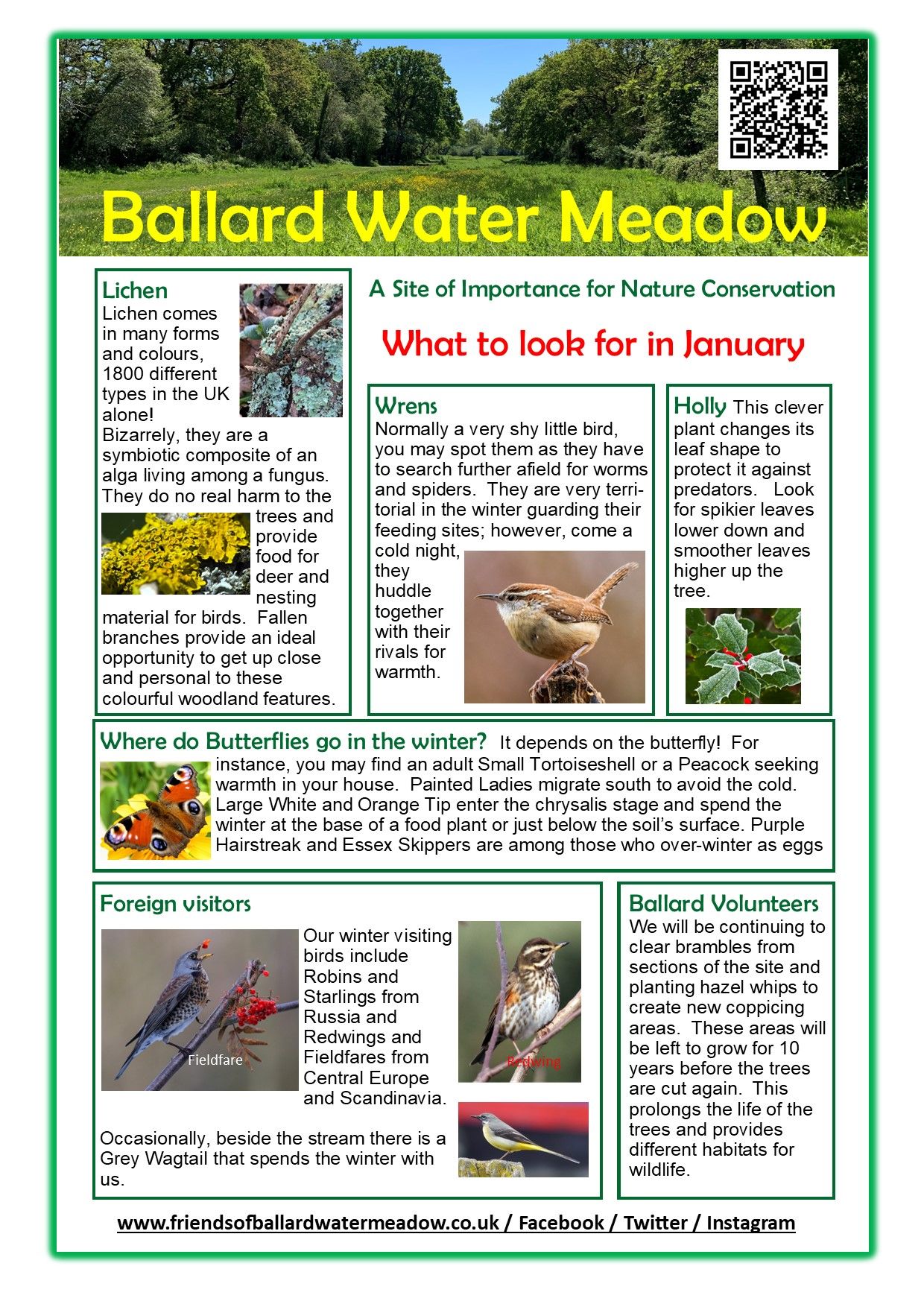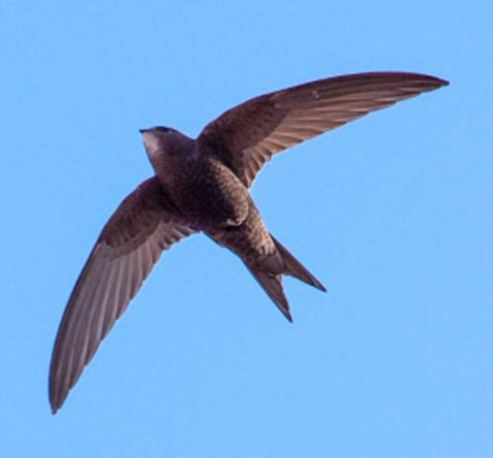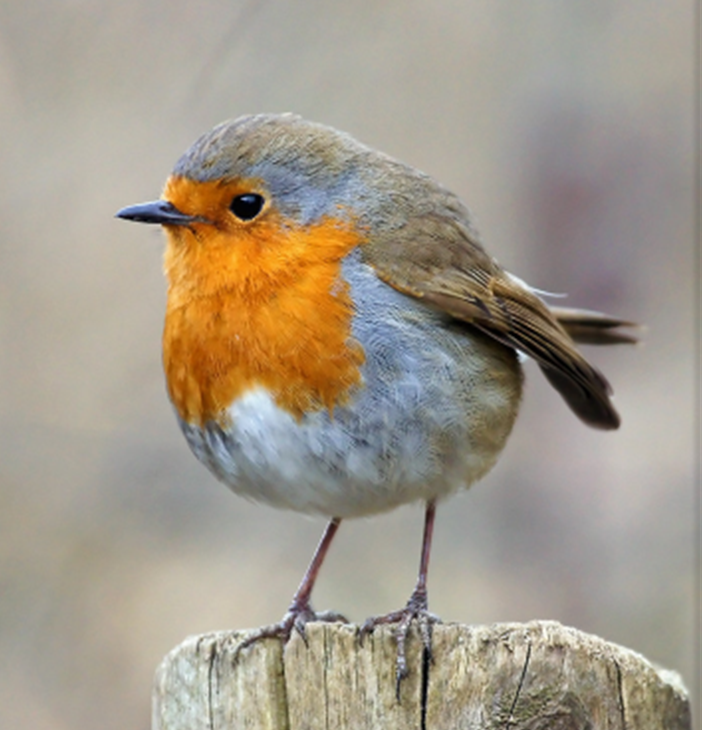Annual Report April to March 2022

BALLARD MEADOW AND WOODLAND
ANNUAL REPORT
FOR
APRIL 2021 – MARCH 2022

Bluebells, Woar Copse
INTRODUCTION
This is the second annual report provided by The Friends of Ballard Water Meadow. Our work on the site is directed by the Management Plan (2020-2024) where we follow the Work Programme from which our Annual Work Plan is derived. Like many plans, and our work plan is no different, the majority of work has been achieved whilst some tasks, often outside our control, remain wanting.
1. RECORDING
Two types of records are kept; events which occur on-site that have a bearing on management or wildlife including volunteer effort (see below), and wildlife recording that is more structured taking the form of a detailed survey, census or transect.
There are plants which are associated with particular habitats and are known as Indicator Species. These are recorded annually, by individual compartment. Each of the meadow indicator species is assessed more closely in terms of either counts or the percentage cover over the ground (where individuals are too numerous to count easily), whereas the woodland element is recorded, simply as presence or absence. Results from the meadow in 2021 are shown in APPENDIX 1. All plants recorded to date by year, across the whole site (our Master List) is shown in APPENDIX 6.
The plant list is by no means complete and new species are recorded each year. In 2021 there were six new species found in the meadow (Sneezewort, Wavy Bitter-cress, Water Horsetail, Butterbur, Hairy Tare and Early Dog-violet) and four in the woodland (Pill Sedge, Rosebay Willowherb, Yellow Archangel and Wood Sage).

Heath Spotted-orchid, Ballard Meadow.
assessing those birds which establish territories and may use the site for breeding. A bird seen in April for example, does not mean it is breeding but if recorded singing, or carrying nesting material, then it probably means it is establishing, or has, a territory. Full details of the census done for 2021, is available on the Friends of Ballard Water Meadows website and a summary is shown in APPENDIX 2.
New Milton Town Council and the Group jointly employed a local entomologist, Bryan Pinchen to undertake the second annual insect survey. The results have been posted both on the Town Council’s and the Group’s websites. A total of 338 species were recorded in 2021 (compared to 314 in 2020), 65 of which were new to the site this year. A summary of Bryan’s work is shown in APPENDIX 3.
The Butterfly Transect undertaken on the site is registered as part of the UK Butterfly Monitoring Scheme. Butterflies are counted along a fixed route and the results feed into national records via local or County recorders. This way, across the country, the status of individual species is known year by year. This year, Ann Gorman, Pam Petherbridge, Rhona Copp, Mandy Hayes and Rosemary Deveraux-Jones contributed, and the 2021 transect summary is shown in APPENDIX 4.
New for 2021, is a stream survey, sampling water chemistry and macro-invertebrates, in association with the Freshwater Habitats Trust. It was intended to run from March to August, but this has been extended, sampling monthly throughout the year when there is a flow. Elsewhere in the New Forest, streams are sampled for their water chemistry, but as far as the Group can tell, macro-invertebrates are not sampled on a regular basis. Of particular note a juvenile newt (eft) was found in May, so we know they are breeding either on-site or close-by. The result of this work is shown in APPENDIX 5.
2. MANAGEMENT
2.1 Wildlife and Conservation Management
The water in the main north-south ditch running through Ballard Meadow attracts frogs to spawn each year. The developing tadpoles face many problems, the biggest threat being a dry spring and the ditches drying-out. Despite placing sandbags to hold water back, the ditch did dry-up in April. We have no idea if any tadpoles reached maturity.
Despite the fact that we had a dry April, the moist ground is particularly suitable for Hemlock Water-dropwort. This is a native wet meadow and streamside species, but in many places, it can become dominant over more delicate, wet meadow plants. We aim to control its spread as much as possible by cutting a proportion of the flowering heads in the spring, before it sets seed. We don’t cut it across the whole site, as the flowers are attractive to a wide range of invertebrates. In April and May we were joined by the Fernhill Friends on a couple of occasions who helped to cut and remove a large proportion of this invasive species. The group had a final attempt to cut and remove more plants in a few selected locations during June.
In the woodland, where we have a proliferation of another invasive species, the non-native Three-cornered Garlic, we managed to cut as many flower-heads as possible. Like the Hemlock Water-dropwort, the aim is to prevent the plant seeding and spreading. We’re hopeful that, over time, we will have removed the majority of plants. The tree guards put around the recently planted hazel saplings were removed in June, we cut-back Bramble from the path edges and cut Bracken to reduce its vigour, in the two glades.
From time to time there is a build-up of leaf litter and fallen branches in places along the stream. The Town Council is obliged to maintain a flow so group members keep vigilant on their behalf, removing any build-up of debris.
We aim to keep the most disruptive habitat management work to a minimum during the April to September period. Some habitat management does inevitably have to take place. Each year at the end of July or beginning of August we cut sections (compartments) of the Meadow. This removes the year’s growth after the majority of plants have set seed, helps de-nutrify the ground and allows a fresh-flush of growth before the livestock are re-introduced in September. We only managed to cut and clear a small area (M9) in early August due to equipment failure, but we hope to be back on track in 2022. We are grateful to the Town Council for taking away the piled-up cut material from all our vegetation clearance work.
The cattle arrived back on the Meadow in September. A local farmer has Dexters, a small and docile breed, ideally suited for our meadow and the number of people with dogs it attracts. On only very few occasions were dogs a nuisance, chasing the livestock.
There are a number of stakeholders in Ballard Meadow and Woodland and sometimes communication between the groups is challenging. In August contractors were engaged to fell trees, in the compartment where the Friends had recently planted some Hazel saplings. A few of these were destroyed in the process and all the material from the work was left on the ground and not cleared away; some actually left blocking a ditch. Then we had storms in October and November which caused a number of the older trees to become unsafe. In removing limbs and clearing fallen branches contractors once again destroyed a number of the newly planted Hazel saplings. A couple of large Oak trees adjacent to the stream also were felled to ground level. It is entirely possible to leave the bole(trunk) of the tree standing in these situations. It is perfectly safe and will provide a holdfast for Ivy and good wildlife habitat for countless generations of invertebrates.
A second compartment (W7) was cut and cleared of Bramble and some fallen timber, ready for restocking with Hazel saplings. This compartment had no old Hazel, only young trees so none was coppiced this time around. The Group was helped by Paul Brockman BEM and his school students. We also returned to the compartment cut in 2020/21 (W1) and coppiced some older hazel stools that were not attended to at that time. All work was completed by the end of February.
In the glades (W4 and W11), the vegetation was cut and cleared in October. One glade is rich in Bluebells, Red Campion and Foxglove whereas the other comprises deep leaf litter and remains fairly species-poor regarding woodland ground flora. As we continue the annual cutting regime, we’re recording the flora and already a few new species are being seen, so it’s only a matter of time before this glade also becomes rich in woodland wildflowers.
Each spring we apply for native hedgerow species for planting along the site boundary. These are supplied free of charge by the Woodland Trust and each year we receive either 30 or 60 plants, depending on the length we need to plant. In February we planted 60 saplings. We also planted around 200 Hazel saplings to fill the gaps in the newly cleared compartment as well as replacing those damaged by contractors in our first coppice compartment. These compartments will now be left to develop for 10 years and then cut again. At the time of writing the vast majority of saplings have taken well, despite April 2022 being one of the driest on record.

Hazel saplings planted in Cpt W7, Woar Copse.
We took a couple of weeks off over the New Year and came back refreshed, cutting and pollarding willows in the Meadow, removing some of the non-native Evergreen Oak trees, clearing the brash (small branches and twigs) and making bonfires to get rid of it all. All of the larger pieces of timber are stacked in the woodland, to make wood walls. These provide habitat for invertebrates and fungi, as well as demarcating our compartments.

Bonfire, Cpt W4, Woar Copse.
Storm Eunice toppled one of the larger Beech trees in February and in March contractors took out the crowns of two Oak trees to allow in more light to the glades. They also cleared-away the brash from the felled Oak trees beside the stream. Thankfully, the ground was really dry and little damage through ground compaction was evident.

Wood wall, Woar Copse.
2.2 Infrastructure
The Group checks the infrastructure (gates, fences, bridges etc) on a regular basis. Small repairs we can do ourselves but the larger jobs require assistance and when anything fails, we inform the Town Council. This year new fencing was installed at the south-east corner access point and against the south-west corner main gate near our workbase.
Under the terms of the grazing licence, the grazier has to check and repair any failure in the fencing, ahead of the livestock being re-introduced. This year a couple of the larger corner/strainer posts were replaced.
2.3 Volunteer work effort
During the period 1st April 2021 to 31st March 2022 the Friends of Ballard Water Meadow volunteers, the Fernhill Friends and the school students’ working parties clocked-up a total of 1522 man hours. We continue to meet twice weekly, Friday and Sunday mornings at 09.30 at our workbase on Lake Grove Road.
3. LIAISON AND ADMINISTRATION
The Friends of Ballard Water Meadow are grateful for the help and support from officers and members of New Milton Town Council and in particular, the Estates and Facilities Management Team.
Throughout the year the Group has worked closely with Fernhill Friends, who not only helped clear Hemlock Water-dropwort from the Meadow, but held a fund-raising quiz night, the proceeds of which were donated to the Friends of Ballard Water Meadow, for which we are grateful.
In order to increase our profile, as one of a number local community groups, we held an event in July to celebrate National Meadow Day and were joined by the New Forest Beekeepers. Also to do with bees, we received financial help from the Hampshire Biodiversity Information Centre (Hampshire County Council) to hold a workshop to train a number of the group in bumblebee identification.
Through our membership of Conservation Connection New Forest South, a small piece of ground was donated by the Town Council at the entrance to Fawcett’s Field, where we sowed native wildflower seed in May which took well, and by July was blooming marvellous! We also joined-in with their celebrations at the Bee Fayre in September. Our own final fund-raising event was on New Milton market in December, selling gift packs of native wildflower seed.
We had three trips to visit other wildlife sites – a butterfly meadow in North Baddesley in July, then in early September, Studland Common, the Pleasure grounds and Sturt Pond with Milford Conservation Volunteers and later in the month, North Solent National Nature Reserve.
Members and officers of the Town Council, along with the New Forest Land Advice Service and the Friends of Ballard Water Meadow, were invited to support Ballard School in their project to plant trees and re-wild a small area of land in the school grounds, adjacent to Ballard Meadow. A plan was drawn-up and the locations for new trees was highlighted.
As part of our Community Involvement, the Chairman was invited to attend the Remembrance Day commemoration at the War Memorial in New Milton and a Christmas Carol service at St Mary Magdalene Church.
The Committee of the Friends of Ballard Water Meadow meet regularly every couple of months and before any event. Our Annual General Meeting was held at the Guide Hut in October. Two committee members resigned, but others were re-elected and we shall be recruiting one or two more to join us during 2022/23.
The Committee now comprises:
Chairman: Bob Lord
Secretary: Ann Gorman
Treasurer/Membership Secretary: Pam Petherbridge
Town Council Representative: Steve Clarke
4. MEMBERSHIP
The friends of Ballard Water meadow are grateful to all those who have renewed their membership for the year. As with all membership groups, there is a turnover and this year we welcomed several new members. Our membership for 2021/22 stands at 51.
5. ACKNOWLEDGEMENTS
As mentioned above, the Friends of Ballard Water Meadow cannot operate in isolation. As a not-for-profit group, we rely heavily on membership subscriptions and donations to keep us running. We have been more fortunate this year in being able to once again, generate some income from fund-raising events.
Many of the members have made donations, for which many thanks and this is gratefully received.
The Committee would particularly like to thank: Fernhill Friends, New Milton Residents’ Association, New Milton Town Council, Paul Brockman and Priestlands School and last, but not least all the willing volunteers who help, come rain or shine.
Bob Lord
Chairman
Friends of Ballard Water Meadow
6. APPENDICES
APPENDIX 1 – MEADOW INDICATOR SPECIES 2021
APPENDIX 2 – COMMON BIRD CENSUS 2021
APPENDIX 3 – INSECT SURVEY 2021
APPENDIX 4 – BUTTERFLY TRANSECT 2021
APPENDIX 5 – STREAM SURVEY 2021
APPENDIX 6 – UPDATED PLANT LIST (1998-2021)


































